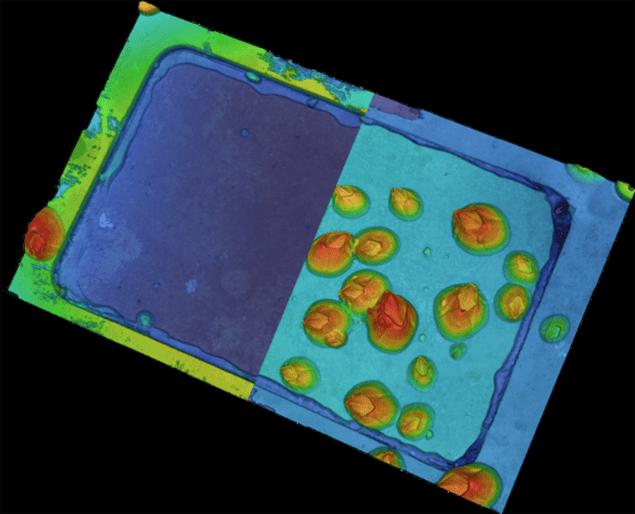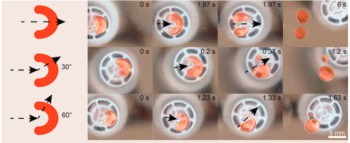
It could soon be much more difficult for barnacles to cling onto the hulls of ships, thanks to a coating of mushroom-shaped microstructures that has been developed by researchers in Germany. The sea creatures – which are a serious problem in marine environments – are unable to completely wet the coating with their glue and form a strong, reliable bond, the researchers say. They add that their coating could help reduce the use of toxic anti-fouling coatings.
Biofouling is the unwanted accumulation of microorganisms, plants, algae and animals on surfaces. Aquatic biofouling affects the aerodynamics of ships and boats, increasing drag and therefore energy use. It can also corrode the surfaces of watercraft and structures such as bridges and wind turbines – and the build-up of organisms makes visual inspections and structural checks difficult.
Biofouling is also an important vector for invasive species. “Imagine your container ship is somewhere in Asia, in the harbour, and marine organisms from that ecosystem attach to the ship hull and then the ship travels to Europe or the US and the organisms detach, or release offspring,” explains Lars Heepe, a materials scientist and biophysicist at Kiel University in Germany.
Permanent fixtures
Of particular concern are so-called hardfoulers, like barnacles and mussels. These sessile marine organisms use adhesive substances to fix themselves permanently to surfaces. Most current strategies to tackle them use anti-fouling paints that stop larvae settling. But, these toxic coatings release harmful chemicals that contribute to marine pollution.
A barnacle’s cement works like most glues, explains Heepe. It starts as a liquid, so that it can flow across surfaces and into any defects before setting hard. As barnacles rely on thoroughly wetting the surface before hardening, to achieve a strong, permanent bond, Heepe and his colleagues wondered if it would be possible to tackle biofouling using purely physical means. They hypothesized that a non-wetting surface topography that the cement cannot completely coat would reduce the adhesive strength of barnacles.
Mushroom microstructures
To test this, they used a silicone-based material covered with mushroom-shaped microstructures – essentially pillars that bulge at the top. The bulges create an upward force on water droplets that prevents them collapsing into the space between the pillars, keeping the cavities dry. By contrast, on a similar surface with micropillars – without the mushroom-like structures at the top – water flows into the cavities between the pillars.
The researchers placed surfaces covered with mushroom-shaped microstructures and micropillars in the Baltic Sea for 17 weeks. For controls, they also submerged flat surfaces covered in the same silicone-based material and acrylic glass.
For the first three weeks barnacles only attached to the control surfaces. From week four to seven they steadily increased on all four surfaces, reaching an average density of 0.7 per 10 cm2 on the mushroom-shaped microstructure and micropillar surfaces, compared with a density of more than 2 per 10 cm2 on the control surfaces.
Zero coverage
Between week seven and 13 the number of barnacles on the mushroom-shaped microstructure surfaces dropped to zero, while the density on the micropillar-covered surfaces remained stable. The density on the silicone control surfaces also dropped to 0.7 per 10 cm2 by week 17, while the barnacles on the acrylic surfaces increased to 4 per 10 cm2.

Mussels modify sinking of small-sized ocean plastics
Dennis Petersen, who is also based at Kiel University, told Physics World that it was already known that barnacle larvae settle at lower rates on surfaces with pillar microstructures – they appear to sense that they may not be good surfaces to attach to. Over time, however, they do slowly build up on these surfaces. The problem is that at some point the larvae have to attach somewhere. “It becomes a matter of life and death,” explains Petersen.
Because of this, Petersen says that the team were not interested in a surface that would deter settling – although the surface with the mushroom-shaped microstructures does – but one to which barnacles could not remain attached.
Knocked off
Petersen and Heepe say that their results suggest that the right surface topography can prevent the permanent adhesion of barnacles. Specifically, a surface that resists wetting reduces the contact area between the barnacle and the surface, resulting in a weak bond. They are then knocked off by forces such as natural currents and water flows created as the boat moves.
Marine-science expert Tony Clare of Newcastle University says the results “are interesting and show promise”. He encourages the Kiel team to “explore the utility of the approach beyond barnacles”.
The research is described in the Journal of the Royal Society Interface



